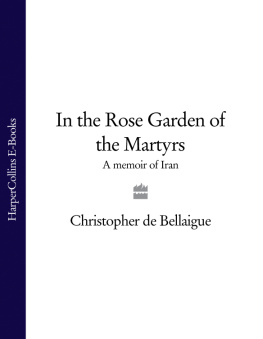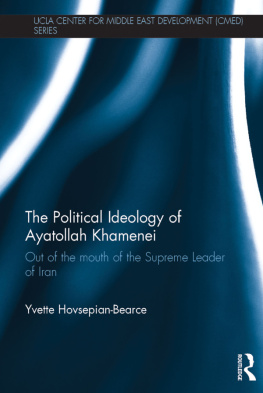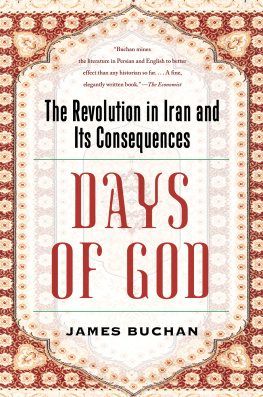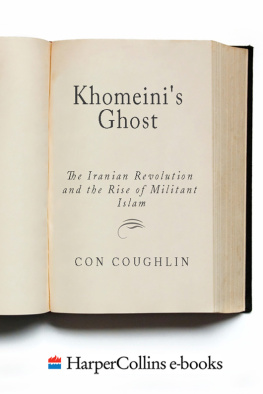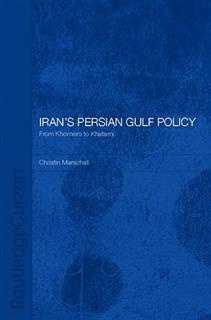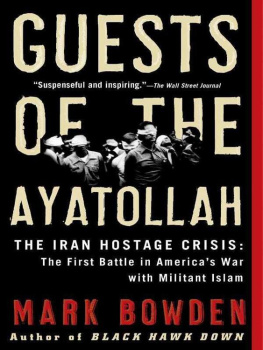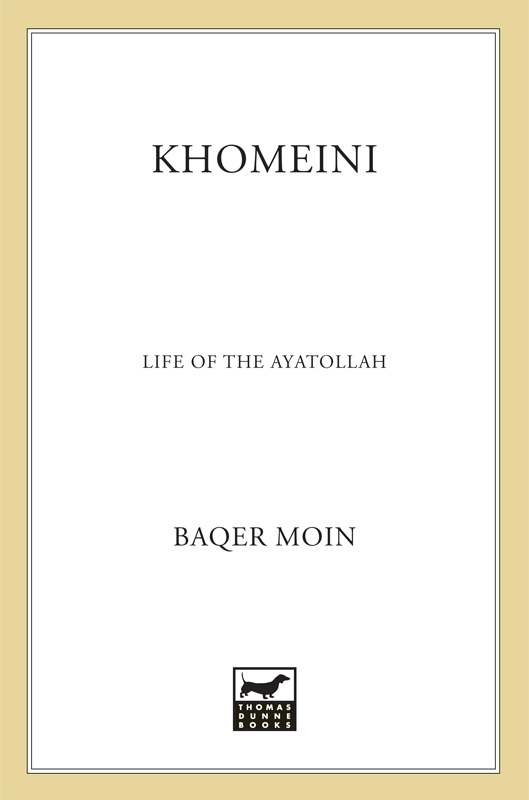Contents
Guide

The author and publisher have provided this e-book to you for your personal use only. You may not make this e-book publicly available in any way. Copyright infringement is against the law. If you believe the copy of this e-book you are reading infringes on the authors copyright, please notify the publisher at: us.macmillanusa.com/piracy.
Contents
I began this biography over a decade ago as a journalistic endeavour designed to make Khomeini explicable to the general reading public. An Iranian working abroad, I had for many years been bombarded with questions about the background and motives of a very tenacious and complex character, and had spent much time trying to correct misconceptions about him and the cultural context in which he flourished. It would, I felt, be helpful to write about him within a serious, but non-academic framework.
I have been, from the outset, well aware of the difficulties of trying to offer a reasonably accurate and objective account of a life that spanned most of the twentieth century and lived in a rapidly changing society. Very little reliable material is available on Khomeinis personal life and early career and many memoirs of him are deeply tinged by the emotions aroused by his political career. Where facts are a scarce commodity, accuracy is not easily attainable. Objectivity though a relative term in itself is even more difficult to achieve when passions run high over a man the consequences of whose actions, sayings and thoughts have touched all our lives.
Ten years after Khomeinis death, history has gradually taken over from emotional and political considerations. The release of more documents, and the information that is now trickling out, will provide opportunities for a deeper and more comprehensive portrait in the future.
This book, for what it is worth, could not have been conceived without my early education as a seminarian in Khorasan my spiritual home. My first teacher was my father, a tolerant and enlightened mojtahed who spent his life as a farmer near Neishabur. He taught me the love of Persian and Arabic poetry and spoke to me of revelation, mysticism, and philosophy; but above all he showed me how to think and to have an open mind. Through him, I met men of remarkable knowledge and spiritual attainment. I am indebted to them and to my teachers in the Mashhad seminaries. Being the black sheep of the family, I ended my time in Iran in quite different circles: among students in Tehran University and my colleagues in the Franklin Book Program. I am much indebted to people I encountered in this period for helping me to see another side of life, especially the late Dr Hamid Enayat, Abdolmohammad Ayati, Mohammad Reza Hakimi, Dr M. R. Shafii Kadkani and Karim Emami.
In writing this book I benefited from my journalistic work in Iran and with the BBC Persian Service, which gave me unique access both to ordinary men and women and to leading players on the political and cultural scene. I would also like to thank the BBC World Service, and in particular John Dunn, Mark Dodd, James Norris, William Crawley and David Page of the former Eastern Service for their help and encouragement.
It was in Oxford, where I lived for some time, that I initially began my research. I spent many fruitful hours at the Middle East Centre, St Antonys College and at Wadham Colleges Persian Library. For these privileges I owe thanks to Dr John Gurney and Dr Derek Hopwood. I should thank Professor Algar of the University of California at Berkeley for generously offering me access to his source material. I am also grateful to many people in Iran, whose names I have not mentioned, for help with sources. Thanks are due to Elahe Mohtasham, Mehrdad Nabili, and especially to Setareh Alavi who kindly read my early drafts. In addition I am grateful to the late Albert Hourani, Dr Homa Katouzian and Dr Mansur Farhang for their advice on earlier versions of the book.
Finally, in finishing this book I was greatly helped by Trevor Mostyn, the late Dr Reza Navabpour, and the late Dr John Cooper.
Above all I am most grateful to my editor Anna Enayat, who completed and edited the text, not only making it more comprehensive but also making me intelligible.
Khomein lies deep in the vast semi-arid areas of central Iran some 200 kilometres to the north-west of Isfahan, the magnificent capital of the Safavid Shahs, and 40 kilometres south of the city of Sultanabad-Arak. At the beginning of the twentieth century it was the administrative centre of Kamareh, a district of Golpayegan province. Yet in todays terms it was no more than a large village with a population of around 2,000 divided into 800 households. Built on the west bank of a tributary of the Qom river, it consisted of a main street fed by numerous alleys, a small shrine covered with blue and white tiles, three caravanserais, three bath houses and a great cluster of mud-brick houses plastered with a mixture of clay and straw to protect them from the eroding effects of the occasional downpour of rain and the ever-blowing wind. The little town was constantly threatened by marauding tribesmen. For this was the country of the Lurs, notorious for their unruly ways until the 1920s when they were pacified under Reza Shah. Khomein was all the same a rather prosperous place. A constant traffic of carts, donkeys and camels made its way through the market place carrying goods along one of the main trade routes between the Persian Gulf ports in the south and the capital, Tehran, to the north. It was surrounded by rich fields of grain, abundant orchards and good pasturelands all watered by the carefully channelled melting snows of the nearby Zagros mountains. A little further afield were some of the finest vineyards in the region from which a dozen or so Jewish families in the nearby village of Lilian produced a very fine araq (spirits).
Ruhollah Khomeini was born on 24 September 1902 in a house that stood in a large garden on the eastern edge of the village. A spacious two-storied structure built around three courtyards in a style common to the homes of the prosperous throughout provincial Iran, it had cool balconies and two tall watchtowers one overlooking the river to the fields beyond and the other the surrounding streets and gardens. Throughout Khomeinis childhood this large fortified compound was alive with activity. His widowed mother Hajieh Khanum rented the andaruni, the old family and womens quarters, to the provincial governors deputy in Kamareh who used the first floor as his offices and the second as a billet for his guards. Hajieh Khanum herself lived with her five children, her sister-in-law, her co-wife and their guards and servants in what was known as the biruni, the outer courtyard of the house normally used for guests and as the mens quarter.
Outside the house, on almost any warm evening, noisy groups of boys would play in the street. A favourite game among them was the thief and the vizier ( dozd-o-vazir ) in which a thief is captured by guards and brought to the court of a king who commands his vizier to have the wretched man punished. Ruhollah Khomeini loved dozd-o-vazir. He was a particularly striking boy of above average build, and he had a decorum that betrayed his membership in one of the more prominent families of the area. Even his friends seem to have noticed the difference between themselves and this charismatic child, for whenever he joined the game he was at least the vizier, if not the Shah himself. Even as a youngster, my father always wanted to be the Shah in the games he played, says Khomeinis son Ahmad.


